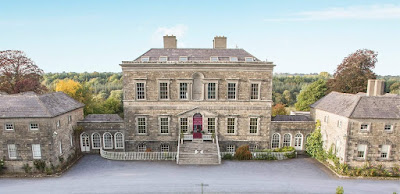THE PRESTONS OWNED 7,415 ACRES OF LAND IN COUNTY MEATH
THE HON MARTIN PRESTON, son of
Jenico, 3rd Viscount Gormanston, by the Lady Catherine FitzGerald, eldest daughter of Gerald, 9th Earl of Kildare, and brother of Christopher, 4th Viscount Gormanston, married, in 1584, Alisona Herbert, and was father of
HUGH PRESTON, of Bolton, Lancashire, who by marriage with a daughter of Jocelyn Nangle, of Navan, acquired with her the lands of Tara and Ardsallagh, County Meath, and Emo, Queen's County.
His son,
JOHN PRESTON, of Dublin, and of Ardsallagh, County Meath, Mayor of Dublin, 1653, MP for Navan, 1661-66, married firstly, Mary, daughter of John Morris, of Bolton, and had issue,
Phineas, of Ardsallagh;
Samuel, of Emo, Queen's County;
Mary.
He wedded secondly, in 1660, Katherine, daughter of John Ashburnham, and widow of Sir John Sherlock, Knight, but by her had no issue.
Mr Preston espoused thirdly, in 1676, Anne, daughter of Alderman
Richard Tighe, of Dublin, and widow of
Theophilus Sandford, and had further issue,
JOHN, of whom hereafter;
Nathaniel, MP for Navan.
Mr Preston's third son,
JOHN PRESTON (1677-1732), of Bellsone, County Meath, MP for County Meath, 1709-32, married firstly, in 1698, Lydia, daughter of Joseph Pratt, of
Cabra; and secondly, in 1720, Henrietta, daughter of
Sir Thomas Taylor, 1st Baronet.
He was succeeded by his son and heir,
JOHN PRESTON (1700-53), of Bellinter, County Meath, MP for Navan, 1732-53, who wedded Anne, youngest sister of Peter, 1st Earl Ludlow, and had issue,
JOHN, his heir;
Joseph.
The elder son,
JOHN PRESTON, MP for Navan, 1761-81, espoused, in 1758, Mary, sister of the
Rt Hon Sir Skeffington Smyth Bt, of Tinny Park, who died in 1781, leaving issue,
JOHN, his heir;
James;
Joseph;
Skeffington;
Francis;
Mary; Elisha; Elizabeth; Emma.
The eldest son,
JOHN PRESTON (1764-1821), MP for Navan, 1783-1800, was elevated to the peerage, in 1800, in the dignity of BARON TARA, of Bellinter, County Meath.
His lordship married, in 1801, Harriet, daughter of Thomas Jelf-Powis, of Berwick House, Shropshire; but died without issue, in 1821, when the title expired.
 |
| Entrance Front (Image: TripAdvisor, 2019) |
BELLINTER HOUSE, near Navan, County Meath, is a Palladian mansion of 1750, designed by Richard Castle for John Preston MP.
The centre block comprises five bays and two storeys, with a basement.
A pair of smaller wings, of five bays and two storeys, are adjoined to the main block by straight arcades.
 |
| Garden Front (Image: TripAdvisor, 2019) |
There is a niche between the first floor windows, directly above the porch which probably contained a statue.
 |
| The Hall (Image: TripAdvisor, 2019) |
The hall is notable for having a magnificent stone chimneypiece with a Bacchantic mask.
Bellinter passed out of the Preston family in 1892, when John Joseph Preston bequeathed the estate to Gustavus Villiers Briscoe, High Sheriff of County Meath, 1897, said to be a family friend.
The Briscoes sold Bellinter in 1955 to the Holdsworth family, who lived there until 1966; and thereafter it was acquired by a religious order, the Sisters of Sion, who sold it to the present owners in 2004.
Bellinter House is now a hotel.
Tara arms courtesy of European Heraldry.






